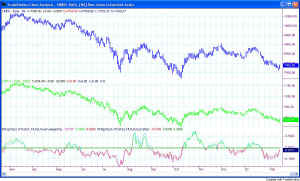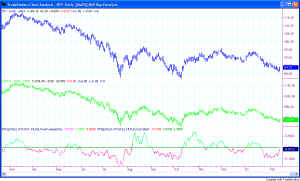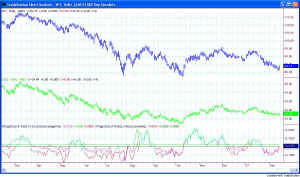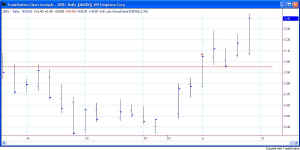NAVIGATION:
| SSS Bulletin Board |
| How to use our commentary |
| FAQ |
| Member sign in |
| Free week guest |
| I want to read about the benefits |
| View Daily Archives |
| View Weekly Archives |

"The Sunny Side of the Street"
MONDAY NIGHT--February 17, 2003
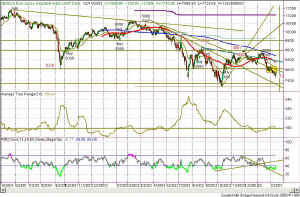 Figure 1 -Daily INDU chart [click to enlarge] A happy post-holiday to all of you. It's nice to have a break now and then. In fact, that upcoming long weekend was probably the reason for Friday' short-covering rally toward the end of the trading session. Who would want to get caught with positions open over a 3 or 4 day holiday in times such as these? [more...] |
|
||||||||||||||||||||||||||||||
[more...]
My 5-minute model got short in the beginning of the day, just as the RSI reached out above 65 and turned around. In order to have made profit from that trade you would have needed to sell quickly and take profits at the 81.99 Attractor, where prices bounced and began the climb for the remainder of the day.
One of my clients asked why I had abandoned the QQQs in favor of the SPY. He trades the QQQs and wants to continue with the information I supplied on the QQQs. So, for this weekend commentary I am taking the time to show all of you how showing one can imply the others.
Using Relative Strength (not the RSI Index) to compare indices, I can easily demonstrate how the S&P, the QQQs and the Dow all compare.
Relative Strength (RS) is arrived at by comparing two different stocks or 2 different indexes, or any two different entities to see how much alike or unalike they are. Often the analyst will simply Divide the price of one security by the price of the other security. For instance, IBM/SPY would give you a value that is a straight line as the two indexes progress.
This is not the style of output I am looking for, however. I want to be able to compare two indices as they are in synch and when they begin to diverge. In order to accomplish this, we would need to take the percentage of pain with market 1 and compare it to the percentage of pain (or pleasure) with market 2. I do this by computing the percentage gain (or loss) of market 1 and for market 2. Then I draw a chart where the percentage gain/loss is the chart for both markets.
For instance, looking at any old stock and comparing it to the S&P Index is a good way to start.
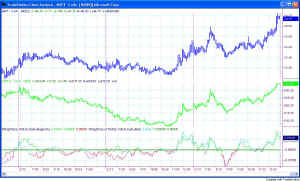
Figure 2 - MSFT vs SPX
[click to
enlarge]
The two lines (green and blue) in the two top subgraphs show MSFT and SPX separately. In the third subgraph is a plot of two percent change lines. You can readily see that there are times when the two lines are coincident, and times where they diverge. This method of comparing data from two different stocks is, to my way of thinking, a more fair comparison method. Here we are looking at the percent of change of each stock and comparing the percent of change of each stock. If they both were in tight coincidence, we could say that they are relatively the same. If one moved up when the other moved down, they certainly would not be relatively the same.
So, using that method, let's compare the Dow to the S&P. In Figure3
you can see that the SPX and the INDU very closely coincide, although there are times that they were not in perfect lock-step. While they generally move the same direction at the same time, often the INDU will move a slightly larger percentage move than the SPX.
Even more in lock-step are the SPY and the SPX shown in Figure 4. We should expect this as the SPY is essentially 10th of the SPX.
Now, what about the SPY vs the QQQ, which is what brought on the question in the first place? These two are in the chart in Figure 5. Again, we see to indices in very close correlation. Yes, there are times when the SPY moves more points than the QQQ, but they get back in step very quickly. And of important note, they are not moving in opposite directions.
So, when I give my prognostication of the SPY, it also applies to the QQQ. And when I give my preditions about the QQQ it also applies to the INDU. They will all be moving there together. Over the next few days I will figure out the multiplier so you can compute the multiples if you wish.
So, as always, stay nimble, humble and take small losses and big wins.
![]() Updated Seminar Schedule -- click here
for new dates.
Updated Seminar Schedule -- click here
for new dates.
Weekly Stock Picks for the week beginning 2/17/2003:
| Symbol | Breakout | Stop Loss | Goal | Close if Triggered | Profit/Loss |
| ADI | 27.026 | ||||
| AGN | 61.5 | ||||
| ADM | 12.232 | ||||
| APD | 40.98 | ||||
| ASH | 28.096 | ||||
| BBBY | 31.62 | ||||
| BCC | 26 | ||||
| TOTAL |
Weekly Stock Picks for the week beginning 2/09/2003:
| Symbol | Breakout | Stop Loss | Goal | Close if Triggered | Profit/Loss |
| ACV | 51.54 | 49.5 | 53.22 | 51.7 | 160 |
| AGN | 62 | 60 | 64 | no | |
| AMGN | 52 | 50 | 54 | 53.96 | 1960 |
| QCOM | 38.37 | 36.67 | 40 | 36.67 | -1700 |
| BDX | 33.5 | 32.5 | 34 | no | |
| BEL | 7.88 | 7.06 | 9.3 | 8.0 | 120 |
| BGG | 43.6 | 42.35 | 45.48 | no | |
| TOTAL | $540 |
![]()
